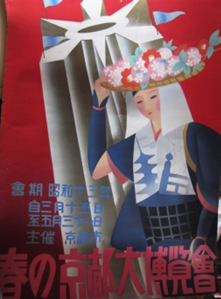Yaichiro Nishizawa a long-established owner of Kyoto who was involved in the return of Okinawa
Congratulations! 50 years since the return of Okinawa
Yaichiro Nishizawa a long-established owner of Kyoto who was involved in the return of Okinawa
Yoshie Doi
 |
 |
Poster for the 1938 Kyoto Grand Exposition created by Mr. Yaichiro Nishizawa Poster for the Kyoto City Planning Division (Showa 25)
Mr. Yaichiro Nishizawa, who created the Okinawa prefecture chapter, is a graduate of the current Kyoto City University of Arts, but many of the painters who had a great influence on the Japanese art world are from Kyoto City University of Arts, and they were taken care of by Kyoto City University of Arts. The painter Taisuke Hamada is also a graduate of Kyoto City University of Arts. I heard a long time ago that he was asked “what kind of painter do you want to be” at the entrance examination and said “I want to be a painter who exceeds the teachers sitting here”. I remember being impressed by the depth and scale of the university in Kyoto, which can handle this kind of response at the entrance examination.
This free atmosphere and the traditional atmosphere of Kyoto are fused to create the aesthetic sense and tradition of Kyoto. The innovative design of Mr. Yaichiro Nishizawa is actually an advanced design backed by tradition.
The tradition and sensibility of the 11th generation of Kenbisha from the 3rd year of Genroku (1690) has been passed down from Yaichiro to the 12th and 13th generations.
Kimono designs have traditionally had many meanings. It seems that the military commander dyed the dragonfly pattern on the lining of the haori and wore it during the Warring States period. Because the dragonfly is the winning insect. Dragonflies are said to fly at speeds of 80 to 100 kilometers per hour. History where the characteristics and patterns of these insects are fused is potentially in Kyoto. People in the kimono industry are familiar with the essence and seem to have the innovation backed by tradition. This is also a characteristic of Kyoto.
The poster introduced above is also so novel that it cannot be thought of as it was in the 10’s and 25’s of the Showa era. I am impressed with Yaichiro Nishizawa’s foresight and universality.
The end of document
